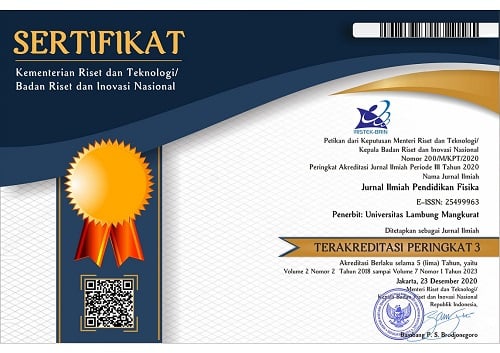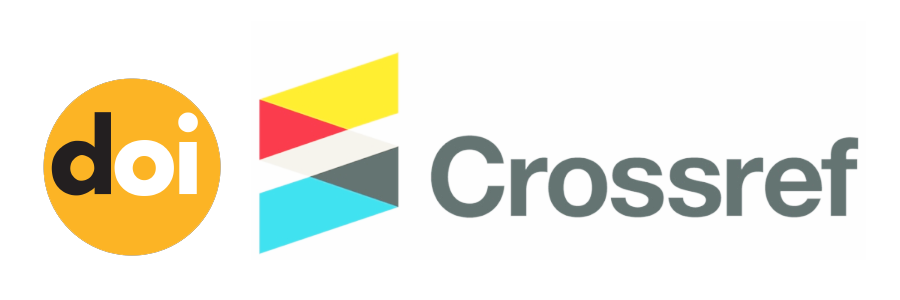Implementation of Assignment-Assisted Video-Based Online Learning to Increase the Intelligent Character Values of Physics Teacher Candidates
Abstract
This research was motivated by the ineffectiveness of learning physics during the pandemic. Subject lecturers apply a solution to learning, namely implementing assignment-assisted video-based learning. This study aimed to increase the value of the intelligent character of physics teacher candidate students. This research is classroom action research that consists of two cycles. The research subjects were ten physics teacher candidates teaching optical physics courses. The research instruments used were student character observation sheets and intelligence tests. Data analysis techniques using descriptive statistical analysis. The results showed increased acquisition of intelligent character scores for physics teacher candidates in each cycle. The highest increase is in grade II in the range of 75-95. The conclusion that can be drawn from this research is that implementing assignment-assisted video-based online learning can increase the intelligence character scores of prospective physics teacher students and is at grade II in the range 75-95 (above average intelligence). This research provides an overview of learning innovations for teachers for classroom application in physics learning. By implementing learning videos, students were actively involved in constructing knowledge, attitudes, and skills both personally and in groups, so the implication of implementing video-based learning assignments was to create a young generation with character in the development of science, technology, and society, where students have been able to implement character values in applying online learning technology. In this case, the student has high integrity and character based on Islamic and Muhammadiyah values.
Keywords
Full Text:
PDFReferences
Abel, J. R., & Deitz, R. (2015). Agglomeration and job matching among college graduates. Regional Science and Urban Economics, 51, 14–24. https://doi.org/https://doi.org/10.1016/j.regsciurbeco.2014.12.001
Agusriadi, A., Elihami, E., Mutmainnah, M., & Busa, Y. (2021). Technical guidance for learning management in a video conference with the zoom and youtube application in the covid-19 pandemic era. Journal of Physics: Conference Series, 1783(1), 0–6. https://doi.org/10.1088/1742-6596/1783/1/012119
Aninnas, A., & Wicaksono, I. (2022). Pengaruh pemanfaatan video fenomena alam dalam pembelajaran ipa materi lapisan bumi terhadap kreativitas ilmiah siswa mts. 10(1), 29–34.
Bayham, J., & Fenichel, E. P. (2020). Impact of school closures for COVID-19 on the US health-care workforce and net mortality: a modelling study. The Lancet Public Health, 5(5), e271–e278. https://doi.org/10.1016/S2468-2667(20)30082-7
Brame, C. J. (2016). Effective educational videos: Principles and guidelines for maximizing student learning from video content. CBE Life Sciences Education, 15(4), es6.1-es6.6. https://doi.org/10.1187/cbe.16-03-0125
Chau, B. K. H., Sallet, J., Papageorgiou, G. K., Noonan, M. A. P., Bell, A. H., Walton, M. E., & Rushworth, M. F. S. (2015). Contrasting roles for orbitofrontal cortex and amygdala in credit assignment and learning in macaques. Neuron, 87(5), 1106–1118. https://doi.org/10.1016/j.neuron.2015.08.018
Chu, X., Gao, D., Cheng, S., Wu, L., Chen, J., Shi, Y., & Qin, Q. (2019). Worker assignment with learning-forgetting effect in cellular manufacturing system using adaptive memetic differential search algorithm. Computers & Industrial Engineering, 136(2), 381–396.
Dhawan, S. (2020). Online learning: A panacea in the time of covid-19 crisis. Journal of Educational Technology Systems, 49(1), 5–22. https://doi.org/10.1177/0047239520934018
Dinmore, S. (2019). Beyond lecture capture: Creating digital video content for online learning – a case study Stuart. Journal of University Teaching & Learning Practice Volume, 16(1), 11.
Diwanji, P., Simon, B. P., Marki, M., Korkut, S., & Dornberger, R. (2015). Success factors of online learning videos. 2014 International Conference on Interactive Mobile Communication Technologies and Learning (IMCL2014). https://doi.org/10.1109/IMCTL.2014.7011119
Fadillah, I., & Maryanti, R. (2021). Application of learning videos and Quizizz in increasing students interest in learning English in middle schools. Indonesian Journal of Multidiciplary, 1(2), 329–336.
Johnson, H. L., Dunlap, J. C., Verma, G., McClintonk, E., Debay, D. J., & Bourdeaux, B. (2019). Video-based teaching playgrounds: designing online learning opportunities to foster professional noticing of teaching practices. TechTrends, 63(1), 160–169.
Laila, K., & Hendriyanto. (2021). Menghadapi Kenormalan Baru dalam Dunia Pendidikan. Direktorat Sekolah Dasar.
Lase, F., & Halawa, N. (2022). Mendidik peserta didik dengan nilai nilai
karakter cerdas jujur. Educativo: Jurnal Pendidikan, 1(1), 190–206. https://doi.org/10.56248/educativo.v1i1.28
Ma’Ruf, M., Handayani, Y., Marisda, D. H., & Riskawati, R. (2020). The needs analysis of basic physics learning devices based on hybrid learning. Journal of Physics: Conference Series, 1422(1). https://doi.org/10.1088/1742-6596/1422/1/012029
Marisda, D. H., & Handayani, Y. (2020). Model pembelajaran kolaboratif berbasis tugas sebagai alternatif pembelajaran fisika matematika. Prosiding Seminar Nasional Fisika PPs Universitas Negeri Makassar, 2, 9–12.
Marisda, D. H., & Ma’Ruf, M. (2021). Situation analysis of mathematical physics learning with online learning during the COVID-19 pandemic. Journal of Physics: Conference Series, 1806(1), 15–20. https://doi.org/10.1088/1742-6596/1806/1/012034
Nisa, A. N. S., Ginanjar, A., & Hermanto, F. (2021). Analysis of the need for social studies learning media based on local advantages of semarang city. IOP Conference Series: Earth and Environmental Science, 747(1). https://doi.org/10.1088/1755-1315/747/1/012079
Nurafiati, S., Rahayu, T., & Sugiharto, H. P. (2021). Strategy for strengthening character education in physical education learning at makassar city elementary education Level. Journal of Hunan University …, 48(6).
http://jonuns.com/index.php/journal/article/view/622%0Ahttps://jonuns.com/index.php/journal/article/viewFile/622/619
Nurfitri, K. (2019). Peningkatan kompetensi web design peserta didik menggunakan metode “rekam layar” di lkp elite english school. J-SAKTI (Jurnal Sains Komputer Dan Informatika), 3(2), 401. https://doi.org/10.30645/j-sakti.v3i2.158
Olson, J. S. (2014). Opportunities, obstacles, and options: first-generation college graduates and social cognitive career theory. Journal of Career Development, 41(3). https://doi.org/https://doi.org/10.1177/0894845313486352
Priyadi, R., Kusairi, S., & Indrasari, N. (2018). Desain dan pengembangan video pembelajaran gerak parabola sebagai fasilitas remediasi siswa design and development of parabolic motion learning videos as a student remediation facility. Jurnal Pendidikan Matematika Dan Sains, 4(1), 20–28.
Retnowati, S., Riyadi, & Subanti, S. (2020). The stem approach: the development of rectangular module to improve critical thinking skill. Online Journal of Education and Teaching (IOJET), 7(1), 2–15.
Riduwan. (2018). Dasar-dasar statistika (P. D. Iswarta (ed.); 15th ed.). Alfabeta.
Rokhim, D. A., Widarti, H. R., & Syafruddin, A. B. (2022). Analysis of teaching material needs on corrosion topic electrochemical materials based on the stem-pjbl approach assisted by learning videos. 10(1), 50–61.
Rusman. (2012). Belajar dan pembelajaran berbasis komputer mengembangkan profesionalisme guru abad 21. Alfabeta.
Sahin, A., Ekmekci, A., & Waxman, H. C. (2017). The relationships among high school STEM learning experiences, expectations, and mathematics and science efficacy and the likelihood of majoring in STEM in college. International Journal of Science Education, 39(11),
–1572.
https://doi.org/https://doi.org/10.1080/09500693.2017.1341067
Shofwan, I., Raharjo, T. J., Achmad Rifai, R. C., Fakhruddin, F., Sutarto, J., Utsman, U., Arbarini, M., Suminar, T., Mulyono, S. E., Kisworo, B., Malik, A., Yusuf, A., Ilyas, I., Desmawati, L., & Umanailo, M. C. B. (2019). Non-formal learning strategy based on tahfidz and character in the primary school. International Journal of Scientific and Technology Research, 8(10), 1987–1992.
Simamora, R. M. (2020). The challenges of online learning during the covid-19 pandemic: an essay analysis of performing arts education students. Studies in Learning and Teaching, 1(2), 86–103. https://doi.org/10.46627/silet.v1i2.38
Singh, V., Abdellahi, S., Maher, M. Lou, & Latulipe, C. (2016). The video collaboratory as a learning environment. SIGCSE 2016 - Proceedings of the 47th ACM Technical Symposium on Computing Science Education, 352–357. https://doi.org/10.1145/2839509.2844588
Sisdiana, E., Sofyatiningrum, E., Krisna, F. N., & Rakhmah, D. N. (2019). Evaluasi pelaksanaan pembelajaran kurikulum 2013. In I. K. dewi Hermawan, N. Listiawati, & Y. Wirda (Eds.), Kementerian Pendidikan Dan Kebudayaan (Cetakan pe). Pusat Penelitian Kebijakan Pendidikan dan Kebudayaan, Badan Penelitian dan Pengembangan, Kementerian Pendidikan dan Kebudayaan.
Stewart, C., & Wall, A. (2016). Mixed signals: do college graduates have the soft skills that employers want? leadership and corporate social responsibility in sports view project soft skills in college graduates view project. Competition Forum, January 2016. https://www.researchgate.net/publication/316066488
Suana, W., Maharta, N., Nyeneng, I. D. P., & Wahyuni, S. (2017). Design and implementation of schoology-based blended learning media for basic physics i course. Jurnal Pendidikan IPA Indonesia, 6(1), 170–178.
Suhery, Putra, T. J., & Jasmalinda. (2020). Sosialisasi penggunaan aplikasi zoom meeting dan google classroom pada guru di sdn 17 mata air padang selatan. Jurnal Inovasi Penelitian, 1(3), 129–132.
Sukayati. (2012). Pembelajaran Pecahan di Sekolah Dasar. CV. Empat Pilar Pendidikan.
Syafiq, A. N., Rahmawati, A., Anwari, A., & Oktaviana, T. (2021). Increasing speaking skill through youtube video as english learning material during online learning in pandemic covid-19. Elsya : Journal of English Language Studies, 3(1), 50–55. https://doi.org/10.31849/elsya.v3i1.6206
Umari, T., & Rosmawati, R. (2018). Analisis nilai-nilai karakter cerdas mahasiswa fkip universitas riau pekanbaru. Jurnal Educhild: Pendidikan Dan Sosial, 7(2), 118–126.
Wachtler, J., Hubmann, M., Zöhrer, H., & Ebner, M. (2016). An analysis of the use and effect of questions in interactive learning-videos. Smart Learning Environments, 3(1). https://doi.org/10.1186/s40561-016-0033-3
Wicaksana, A. (2016). A change of perspective the pre-graduate expectations versus post-college experiences of theatre arts majors. Https://Medium.Com/, May. https://medium.com/@arifwicaksanaa/pengertian-use-case-a7e576e1b6bf
Wisada, P. D., Sudarma, I. K., & Yuda S, A. I. W. I. (2019). Pengembangan media video pembelajaran berorientasi pendidikan karakter. Journal of Education Technology, 3(3), 140. https://doi.org/10.23887/jet.v3i3.21735
Xu, Y. J. (2013). Career outcomes of stem and non-stem college graduates: persistence in majored-field and influential factors in career choices. Research in Higher Education, 54(3).
Yuliansyah, A., & Ayu, M. (2021). The implementation of project-based assignment in online learning during covid-19. Journal of English Language Teaching and Learning (JELTL), 2(1), 32–38. http://jim.teknokrat.ac.id/index.php/english-language-teaching/index
DOI: https://doi.org/10.20527/jipf.v7i3.10118
Refbacks
- There are currently no refbacks.
Indexed by: Jurnal Ilmiah Pendidikan Fisika is licensed under a creative commons attribution-share alike 4.0 international license
Statistics Counter |

















